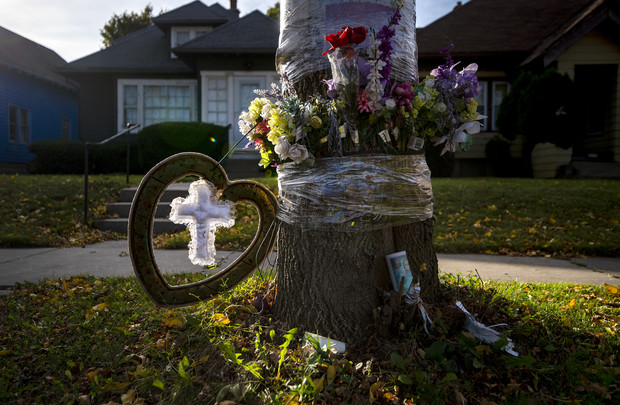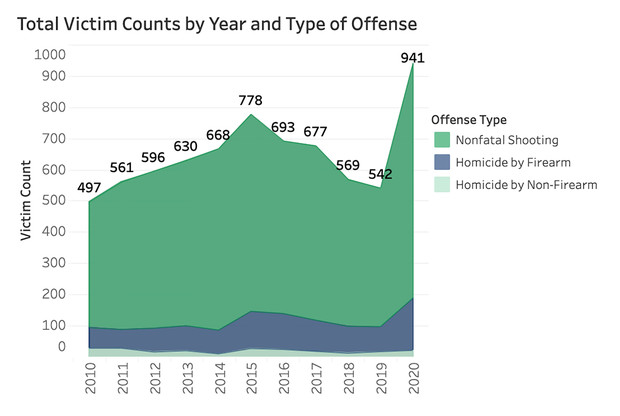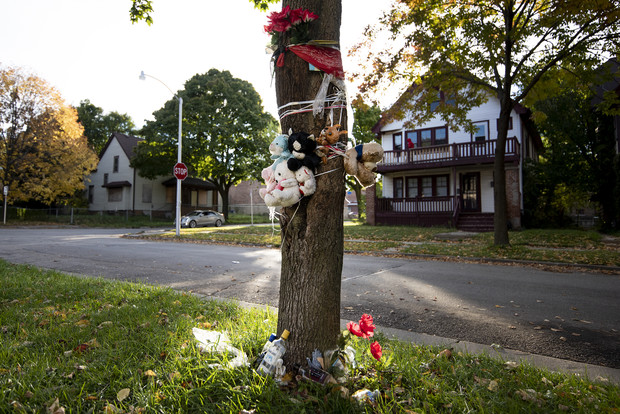Milwaukee Youth Caught In Middle of Rising Violence
Police, government resources unable to break cycle of violence destroying lives.

A memorial for Bianca Bates, a 31-year-old woman who was fatally shot earlier this year, is displayed Tuesday, Oct. 26, 2021, in Sherman Park in Milwaukee, Wis. Angela Major/WPR
Last month, a 47-year-old Oshkosh woman tried to stop four teenagers from stealing a car at a Holiday Inn Express in Wauwatosa. The woman, Sunita Balogun-Olayiwola, was killed when one of the boys got into her car, pushed her out and ran her over several times.
The criminal complaint contains horrific details of the incident that has lead to the 13-year-old boy being charged as an adult in Milwaukee County Circuit Court. Despite being 13 years old, the boy now faces six felony charges and up to 115 years in prison if convicted.
This case is extreme. But it’s one of many violent crimes in Milwaukee County where young people are involved.
Nick DeSiato, chief of staff at the Milwaukee Police Department, said teens have easy access to guns. And younger people are stealing cars and driving recklessly, which is all connected.
“While those may seem like a distinct category, a reckless driver who strikes another vehicle and kills somebody, is still the form of a homicide or the contributing factor for somebody else’s death,” DeSiato said.
Community activist Vaun Mayes says when he was a kid, he was committing crimes too. Mayes grew up in one of Milwaukee’s toughest neighborhoods — Franklin Heights. He now has numbers tattooed on his fingers, representing the block he ran when he grew up on 25th Street and Auer Avenue. Groups representing about five different blocks used to fight to protect their neighborhoods, Mayes said. At 15, he was doing what he called “block banging.”
But now, the stakes are much higher.

Photos are attached to a tree as a part of a memorial Tuesday, Oct. 26, 2021, in Milwaukee, Wis. Angela Major/WPR
Now 34, he says it’s still happening. But today kids as young as 12 are using guns instead of fists, and posting the violence on social media to gain notoriety.
“It’s like reality TV on steroids,” he said.
One video posted on Facebook Live, and obtained by WPR, depicts three young women dancing and laughing while pointing a semi-automatic weapon at the screen. Sometimes the videos show teens or young people in stolen vehicles recklessly driving through crowded city streets.
Homicides are up about 32 percent in large cities across the nation, but DeSiato said no city has been hit harder than Milwaukee which has seen an increase three times the national average.
There were 190 homicides in Milwaukee last year, the most on record. Through last week, the city was on pace to pass that number with already more than 160 murders so far this year. More than 740 people have been shot so far this year in Milwaukee, a nearly 25 percent increase over last year.

Graph courtesy of Medical College of Wisconsin Milwaukee Homicides Review
Today’s version of “block banging” can’t be blamed entirely for the increase. Domestic violence homicides are up, and DeSiato said many shootings are retaliation for previous crimes.
One very public example of this was in September, when five people were shot at a vigil in Milwaukee’s Sherman Park neighborhood for a 16-year-old homicide victim.
Milwaukee’s Homicide Review Commission, run through the Medical College of Wisconsin, found about 37 percent of homicides in Milwaukee are the result of a fight. Another 34 percent are classified as “unknown.” DeSiato says those cases are tough, even if police think the deaths are the result of a fight, they can’t prove whether or not they’re retaliation.
Mayes grew up without a home and has had his share of trouble with police. Today, he’s a community activist with a group he started called ComForce MKE, which goes out into neighborhoods like Franklin Heights and Sherman Park and works with residents. Mayes and his team are also active at crime scenes, interviewing witnesses and attempting to keep the peace.
Mayes said kids have a “live fast, die young attitude,” which has made everything more dangerous in the city. But that doesn’t mean they aren’t still kids. Many without much family support.
“A lot of these kids, if you talk to them, when they’re in these cars, they got these guns, they’re like the most tough person ever,” Mayes said. “But if you catch them outside of that, they’re not like that at all, they’re very scared, frail, fragile, sensitive.”
Milwaukee residents are weary, but committed to their neighborhoods
Some residents in communities like Sherman Park are skeptical law enforcement can stem the violence.
Jordan Morales is a member of the Sherman Park Community Association and said it feels like there’s no legal consequences for crimes.
“It feels like the law is on hold in Milwaukee … People who want to take advantage of the city know the police’s resources are strained, they know that the general resident of Milwaukee is afraid of confronting bad behavior, so they know they have a blank check to do what they want,” said Morales, who is not related to former police chief Alfonso Morales.
“I’ve thought about it, but I’m pretty committed to this neighborhood,” Morales said. “Like a lot of the century-old houses in Sherman Park, this neighborhood has really good bones. It just needs some extra investment here, some extra attention from the city.”
According to the Milwaukee Homicide Review, there were 11 homicides in Sherman Park from Jan. 1 through Oct. 6, equating to 16 victims per square mile. During that same time period, there were 27 nonfatal shootings.
When about a dozen gunshots rang out one afternoon in October, Patricia Norman and her daughter barely flinched. Even though the shots sounded close to their quiet, tree-lined street, and they were out on the porch.
“I don’t get scared,” Norman said. “If I feel like if it’s real close, and I’m sitting out here, I know to run my butt in the house.”

Toys and flowers are tied to a tree in the Sherman Park neighborhood Tuesday, Oct. 26, 2021, in Milwaukee, Wis. Angela Major/WPR
Norman moved back to Milwaukee about two years ago and loves the city, but sometimes feels hopeless.
“If they can’t get the guns out of the kids’ hands, there ain’t nothing nobody can do, and it’s not going to stop,” Norman said.
During the 13-year-old boy’s charging hearing in Milwaukee County Circuit Court following the murder of Balogun-Olayiwola, Judge Audrey Skwierawski said the nature of his charges, including first-degree reckless homicide, could not be more serious.
The boy told the court he understood. He also said he wanted to call his mom.
‘The law is on hold in Milwaukee’: Youth are caught in the middle of the city’s climbing homicide rate was originally published by Wisconsin Public Radio.






















Good morning Ms Hess There is a light at the end of the tunnel and it is based upon the work of many but these two individuals best summarize that work. Dr Lonnie Athens PhD lays out clearly the behavioral process that children go through to become “violent” use socially unacceptable behavior. The other is Dr Bessel van der Kolk MD who lays out clearly how the developing brain of a child can be injured by significant trauma. All of the children you speak of in your story have significant brain injuries. Call me – e-mail me and I will gladly explain how it works. Peace Tom Spellman 414 403 1341
Let’s add the fact that with Republicans the last 10 years acting on a parasite of Milwaukee to satiate their white supremacist base has funneled billions out of MKE and we now see less return of funds than we get.